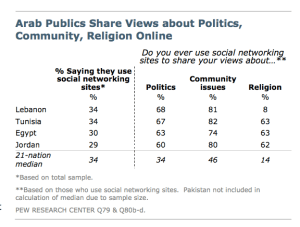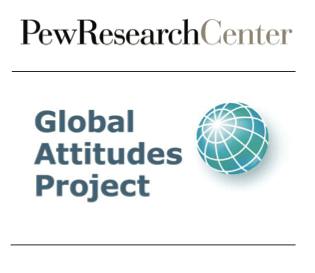The Pew Center has been running a long-term study on U.S. consumer habits on the Internet and other digital media (you can read about past research findings here); today it’s releasing a new set of data that looks at the wider global state of affairs, as part of Pew’s Global Attitudes Project, specifically covering social media and Internet and mobile usage.
A survey of 26,000 consumers across 21 nations, conducted in March and April of this year, found that the UK is the most social-networked country at the moment; that making voice calls is still, on average and by far, the most popular thing to do with a phone; and that events like the Arab Spring have pushed people to use the Internet more to express political opinions.
We’ve embedded the full document below, but here are some of the standout conclusions we have found:
- When it comes to social networking, the UK has the highest proportion of users with 52%, of adults using social media services like Facebook, Twitter and YouTube. The U.S. tied in second place with Russia at 50%, while the Czech Republic and Spain at 49%.
- For the most part, it looks like social media use runs in direct proportion with how widespread Internet usage is. So, for example, 89% of India’s surveyed consumers, and 94% of Pakistan’s, said they had no Internet access, and they were the two least socially-networked countries too, at 6% and 3% respectively. In the UK, only 15% of respondents said they did not have Internet access.
- The one exception here seems to be Russia. It actually has a fairly high proportion of people without access: 40%, according to the report, and yet it still came in tied for second place in social media usage. This could be because Russia is one of the biggest Internet using nations in Europe — so when people are online, they’re online a lot. Brazil has a similar profile to Russia’s, with only half its respondents saying they have Internet access with around 40% of them using social media.
As companies like Facebook know all too well, a lot of social networking, especially in markets with lower PC and broadband penetration, takes place over the mobile phone. In fact, Pew found that in 12 of the countries it surveyed, at least 60% of smartphone users were using their devices to access social networks. The top three for this trend, it said, were Egypt (79%), Mexico (74%) and Greece (72%), where broadband penetration is low.
But how it’s used has some interesting variations depending on the region in question:
- By and large, social networking is used for entertainment. Music and movies, Pew found, were the most popular topics on average across all 21 nations, with 67% of respondents saying that these were the topics discussed most by them. “Community issues,” which could mean anything from chit-chat about friends and your life to local events, came in second at 46%, and sports at 43%.
- Religion is very low down at just 14% — whether that presents and opportunity or challenge to the Pope, who just started tweeting today, remains to be seen.
Politics on average globally is moderately more popular than religion, with a 34% average in terms of social media subject. But that changes when you focus on one specific group, Arabs. While Lebanon, Tunisia, Egypt and Jordan fell very squarely into the global average for social networking usage (around the  30-34% mark), they had double the amount of chatter about politics and, with the stark exception of Lebanon, five times the amount of chatter about religion compared to global averages. Community issues also got double the attention in these Arab nations than they did on average globally.
30-34% mark), they had double the amount of chatter about politics and, with the stark exception of Lebanon, five times the amount of chatter about religion compared to global averages. Community issues also got double the attention in these Arab nations than they did on average globally.
What does this show? That despite some of the restrictions that took place around the Arab Spring protests, the Internet remains a powerful force for information dissemination in communities where it has otherwise been difficult to express opinions through the media.
In mobile phone ownership and usage, Pakistan and India again stood out as having the lowest penetrations at around 50% (again, showing the connection between mobile phones and social media, since these two also had the lowest proportion of social media users). Many many other countries at 80% or higher and the global average at 87%.
Although taking pictures and video are now noted as common mobile activities by 54% of respondents — and those surely have shot up over the years — voice calls remain by far the most popular thing to do on a phone, at 98% of all respondents noting it as their most regular mobile activity.
You might think that this is because smartphones are still are a relatively nascent phenomenon on the global stage — it’s developed countries like the U.S. and UK where smartphones have started to tip past the 50% usage mark; many other countries are far behind that — that voice has remained so popular. But in fact, what keeps it so high is that practically, no matter how fancy their phone is and how many apps it has on it, has pushed away from voice services altogether.
By comparison, Internet usage came out only at 26%. Again, turning to companies like Facebook, which are keen to grow their gobal audiences, this is another sign of how they will need to focus on other ways of accessing their networks, for example by text message (74% global penetration), while they wait for the rest of the world to catch up with the iPhone/Android generation.
